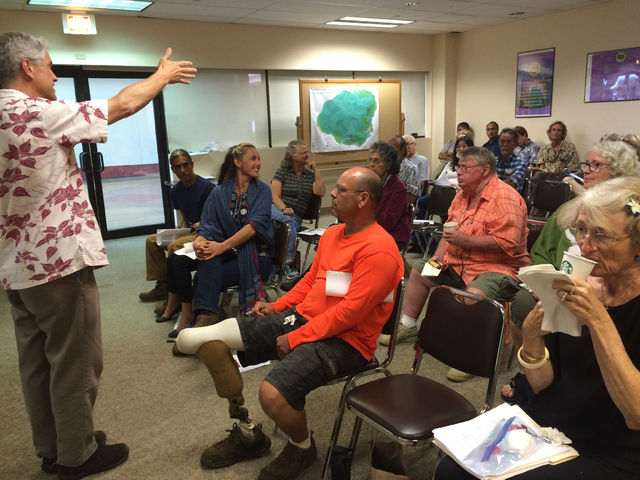LIHUE — Paul Massey believes there should be more disincentives for environmentally harmful agricultural practices. The Kalihaiwai resident and director of Regenerations Community Seed Bank and Library also said he thinks that, in some circumstances, additional dwelling units should be
LIHUE — Paul Massey believes there should be more disincentives for environmentally harmful agricultural practices.
The Kalihaiwai resident and director of Regenerations Community Seed Bank and Library also said he thinks that, in some circumstances, additional dwelling units should be allowed on agricultural land.
“The system should be changed to fit the needs of the people,” Massey said.
Massey was one of around 30 people who joined the Community Advisory Committee’s meeting on agriculture Tuesday afternoon. He and others had a chance to weigh in on the discussion during the breakout session.
David Tarnas, meeting facilitator with Marine and Coastal Solutions International, asked the public a few focused questions and documented feedback.
The crux of the crowd’s concerns was how to make small farming sustainable for the average Kauai family.
Some suggestions were to allow additional dwelling units on ag lands, to revamp the county’s zoning of rural and open zoned lands, to ensure access to clean water and to better protect ag lands from encroachment of other uses.
Most said different types of agriculture – depending on size and on production type – should be distinguished within zoning regulations.
One suggestion was to provide incentives to small farmers instead of targeting large-scale farms for tax breaks, and handing out lower rates for food production instead of cattle grazing.
“Food for the island should take priority over all this other stuff,” said Ken Taylor, Kauai resident. “We should make that happen with policy.”
Though many said they didn’t think it was the role of government to dictate what a farmer can plant, many supported the idea of incentivizing local food production.
“We have to be cognizant of all areas of agriculture,” said Lonnie Sykos, from the Wailua Homesteads. “We do need a certain amount of land always available for food production.”
Jeff Melrose, who created the Statewide Agricultural Land Use Baseline for 2015 report, said around 70 percent of land zoned agricultural acreage statewide is used for export.
“That’s what we do with farms,” Melrose said. “And each region in Hawaii has evolved differently.”
He pointed out there has been a fundamental shift in Hawaii’s agriculture practices, from the large-scale, industrial sugar and pineapple plantations to more rural, small farms.
“Wwoofers (those with the organization World Wide Opportunities on Organic Farms) play a big role in what happens in this kind of agriculture and this is a fairly stable form of ag,” Melrose said. “It’s a fundamental change from decisions made in the board room to decisions made around the kitchen table.”
He said on Kauai, most of the agriculture land is used for activities of seed companies on the south and west sides and there are still a few large-scale players involved. He said the North Shore ag footprint is more fragile and smaller because “wealthy people are buying up the properties.”
“Moloaa is the most productive place for farming on Kauai,” Melrose said.
There are four more meetings left for the Community Advisory Committee, where members will hash out proposed updates to the county’s general plan.


